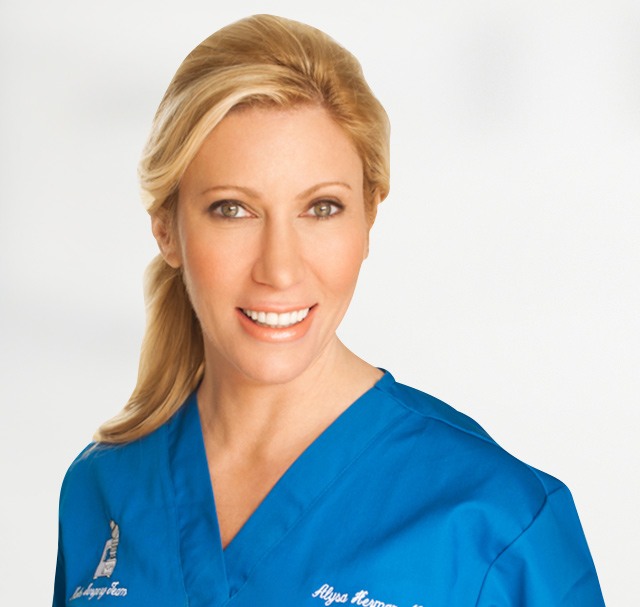Skin Cancer Basics
Skin cancer is the most common type of cancer in the United States, and in the sun-intense state of Florida, skin cancer is particularly prevalent. If you, a family member, or a friend has been diagnosed with skin cancer, learning more about this disease can help you to understand and plan your treatment. When diagnosed and treated early, 99% of skin cancers can be cured.
Dr. Alysa Herman has extensive education, training, and experience focused specifically on Mohs micrographic surgery – the most effective treatment for most types of skin cancer. Based in Miami, she is a board-certified dermatologist and fellowship-trained Mohs surgeon whose focus is screening, educating, and treating patients with this serious condition.
Early detection and treatment can save lives. Request a consultation online today, or call
(305) 444-4979 to schedule your appointment with Dr. Herman.

Dr. Alysa Herman
If you've been diagnosed with skin cancer, you need a physician who is exceptionally qualified, experienced and compassionate. Dr. Herman is renowned among physicians and patients for her credentials and her dedication to patient care.
Request your Consultation ▸
What Is Skin Cancer?
Normal skin cells grow, develop, and die in predictable cycles. In contrast, skin cancer develops when the normal skin cell cycle changes. Rather than dying, the damaged DNA in skin cancer cells causes them to continue growing, resulting in more abnormal cells. In addition, these cells tend to invade other tissues.
Causes of Skin Cancer
Skin cancer most frequently results from exposure to ultraviolet (UV) light, which harms the DNA with repeated exposure. In addition to repeated exposure to UV light outdoors, you are at increased risk of skin cancer if you:
- Frequently use tanning beds
- Regularly smoke cigarettes
- Have a suppressed immune system, such as if you suffer from leukemia or are an organ transplant recipient, because your immune system cannot ward off cancerous cells as effectively as healthy individuals
Testimonials
-
Janet Blanco-Pastor — 5 Stars
ABSOLUTELY a wonderful staff and Doctor. Always very accommodating. You are seen at your appointment time, not 2 hour later. Very considerate of your time and always available to answer any question. Dr. Herman is a very down to earth, beautiful young professional. She is a rare find in today's world. She really cares about her patients. Will not go anywhere else from now on for my MOH's.
-
Metta MacMillan-Hughes — 5 Stars
I have found Dr. Alysa Herman to be extremely professional, a perfectionist when it comes to her surgery and her patient care is excellent. I have 100% confidence and satisfaction in this MOHs surgeon and would highly recommend her.
-
Susana Mateu — 5 Stars
Excellent Dr. and staff, i went to Dr. Herman for mohs surgery and for other concerns about my skin due to abnormal results they were able to walk with me through the process and answer all my questions and concerns. I highly recommend them for mohs surgeries, skin concerns and 2nd opinions.
-
Daniela B. — 5 Stars
I took my mom here for a mole removal surgery. The building has a parking garage and plenty of (pay to park app) spaces on the street. Once you walk in, you sign in and head up to the 7th floor. Dr Herman has a beautiful office with modern decor, and ample space. The staff is bilingual in English/Spanish, they are beyond helpful. The secretaries are on top of everything, they were working non stop the whole time were there. Her PAs are very professional and have such sweet bedside manner.
My mom had her mole removed in less than an hour. The doctor was very thorough, explained the procedure and how to take care of it. Mom felt no pain, and had to be back to take stitches off in one week. We had no problem scheduling her for an early appt in 7days..
-
M A. — 5 Stars
Came in for a consultation and walked out doing a procedure. That is how comfortable Dr. Herman and her staff made us feel. Dr Herman was very professional and took her time explaining everything thoroughly. Office is clean, modern and beautiful. Highly recommend her!
-
Paul C. — 5 Stars
My surgical procedure went very well. Dr Herman made me feel at ease and relaxed.
-
Robin in Coral Gables, FL — 5 stars
I was diagnosed with a Kerancanthenoma. Scary stuff. I then tried to find a surgeon for Mohs surgery to remove it. I found Dr. Herman. She was great. Her office is very nice, staff very helpful and Dr. Herman was great. She even gave me her cell number if I wanted to talk to her. Great results. If you need Mohs surgery, Dr. Herman is the greatest.
-
-
Janet Blanco-Pastor in Miami, FL — 5 Stars
Dr. Herman and her staff are wonderful. She is a true professional and you can tell she likes was she does and cares. They speak with you not talk at you which is important when you dealing with positive results. She puts you a ease. Her staff is awesome. They are ALL respectfull of your time. If your appointment is at 10am, you are seen at 10 am not bounced around through different rooms. Highly, highly recommend.
Types of Skin Cancer
About 99% of diagnosed cases consist of the 3 most common skin cancer types: basal cell carcinoma, squamous cell carcinoma, and melanoma. In addition to the general descriptions provided here, it is important to recognize that skin cancer can have many presentations and varying characteristics. Should you notice any significant skin changes, consult immediately with a dermatologist specializing in skin cancer.
Basal Cell Carcinoma
Accounting for about 80% of all diagnosed skin cancers, basal cell carcinoma is the most common type. It starts in the skin cells located in the lowest part of the epidermis, which are known as the basal cells. According to the American College of Mohs Surgery, basal cell carcinoma generally appears on sun-exposed areas and may look like a blemish that won’t heal or a shiny, pearly bump that does not go away. It may bleed if minor trauma occurs to that area. Alternatively, basal cell carcinoma may look like a rough, reddened patch.
Squamous Cell Carcinoma
Forming just below your skin’s surface in the squamous layer, this form of skin cancer is the second most common type and tends to be more aggressive than basal cell carcinoma. In addition to occurring on sun-exposed areas of your body, it also may appear in other regions, such as the genitals and mucous membranes. Squamous cell carcinoma typically looks like a red, crusted bump or rough, scaly patch, and the American College of Mohs Surgery reports that it sometimes is mistaken for a patch of dry skin or a wart.
Melanoma
Although it accounts for approximately 3% of skin cancer cases, melanoma is the most dangerous type; more than 75% of skin cancer-related deaths result from melanoma. It begins in the cells that produce pigment (melanocytes), which account for the color of your hair, eyes, and skin. Often developing in an existing mole or appearing to be a new mole, melanomas typically are brown to black lesions that, according to the American College of Mohs Surgery, have uneven borders, colors, or surfaces. When they appear on sun-damaged skin such as the face, melanomas may look like a brown patch or unevenly colored freckle. Cure rates are very high if these types of skin cancer cells are detected early. When it spreads to other areas, however, the rate of cure is lower.
Early Detection
In addition to learning details about skin cancer, it’s important to schedule regular appointments with a dermatologist who can examine your skin carefully to look for any suspicious areas. Early detection of skin cancer can save lives. Learn more about skin cancer symptoms and diagnosis.

Dr. Herman is honored as one of Miami’s Top Doctors by Indulge Magazine, highlighting her as one of the city’s few dermatalogic surgeons specializing in Mohs micrographic surgery for skin cancer.
Indulge Top Doc 2017 ▸
Indulge Top Doc 2020 ▸
Back to Top






